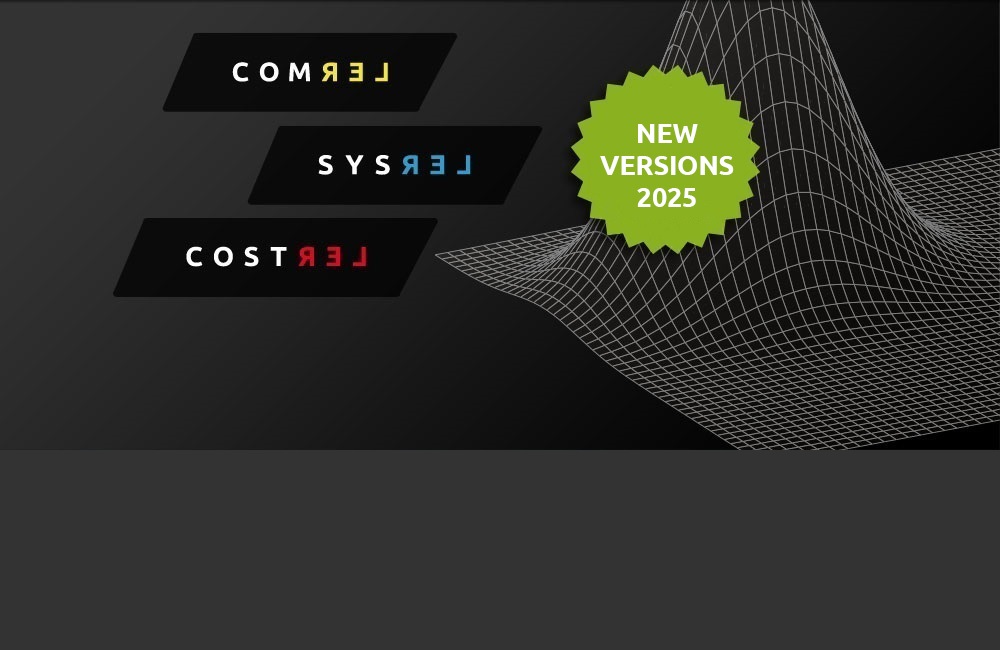
The 2025 release of STRUREL including Comrel, Sysrel and Costrel provides considerably improved handling of interfaces to Maplesoft Maple, Wolfram Research Mathematica, MathWorks Matlab, Python, Ruby, GNU Octave, R, Scilab, Aptech GAUSS engines and newly developed seamless integration for FORTRAN and C/C++ languages. Sophisticated technology to create so called Buildout Add-ons on the fly using latest versions of well-known compilers, such as GNU Fortran/C++, INTEL oneAPI Fortran and Microsoft Visual C++ was implemented. Editing source code is almost identical as for scripts of interpreting engines. A built-in Script Editor provides a syntax coloring, folding support with hot areas for collapsible nodes, automatic detection of URL as a clickable link, braces highlighting, extended RTF export, deep error tracing and numerical evaluation on the fly. STRUREL can now handle MAT and HDF5 files in each interface. Before execution of a changed script the engine will be automatically restarted. In the case of altered source file, a new state of Buildout Add-on will be manufactured and used on the fly. The implementation of special prologue/epilogue function RF99 optimizes visualization of results. Additionally, FORTRAN and C/C++ interfaces contain a simplified built-in connection to Gnuplot that allows produce a wide range of plots too. To provide a quick overview of the examples and to get a feeling of the GUI facilities a very powerful Start-Up Dialog was implemented. Now it is also possible to operate just the numerical core of each module for automation purposes. For example, some external application may call the STRUREL program in an iterative loop for predefined input model and update parameters of interest until some aim is reached. We proudly announce the first successful automation of commercial FEM Suites - FEMAP/NASTRAN and PLAXIS from STRUREL via its Python interface. Furthermore, there are: Retranslator Mathematical Formulas (RMF) that converts text formulae back into mathematical notation, a Help system based on PDF standard, context sensitive help for the Symbolic Expressions Editor, simplified interface functions to all script-based engines, comfortable Run control. The new version of Add-on Creator 2 allows to easily build STRUREL custom Add-Ons. Each standard interface now can generate a Run Script file that encloses all steps of a reliability analysis using the language of the corresponding engine. Therefore, it is possible to execute a bundle of a Run Script together with the corresponding script of the state function on Windows, Linux and macOS without invoking STRUREL software.
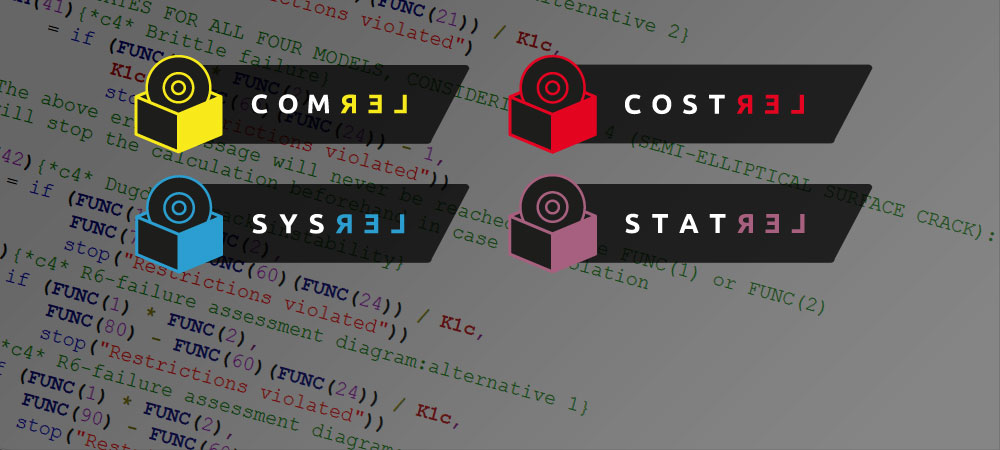
STRUREL is a collection of programs for stuructural reliability analysis. More details can be found here.
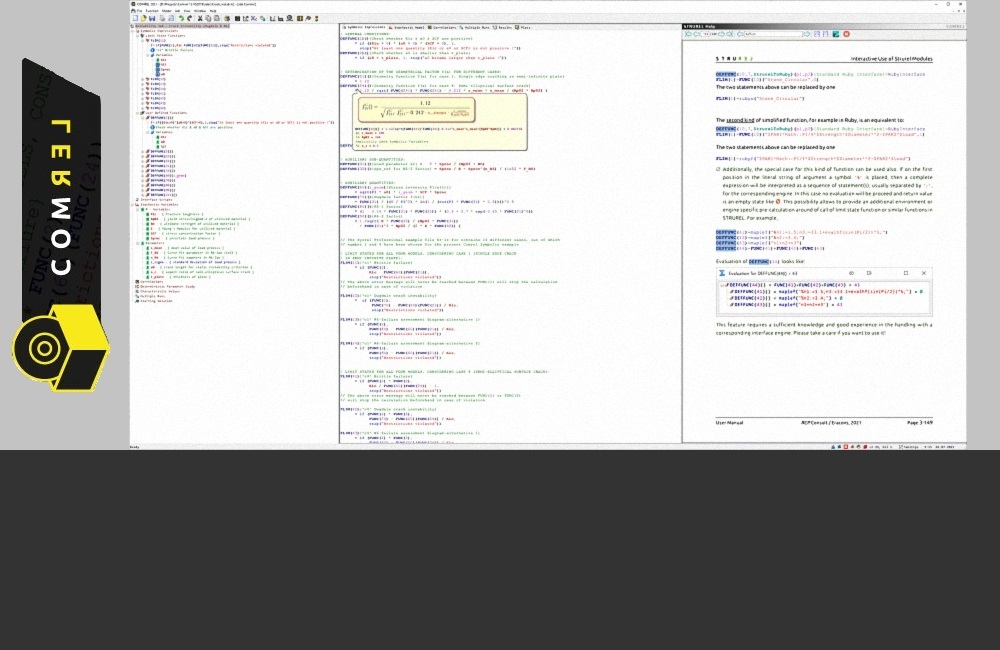
The core package is COMREL for component reliability analysis.
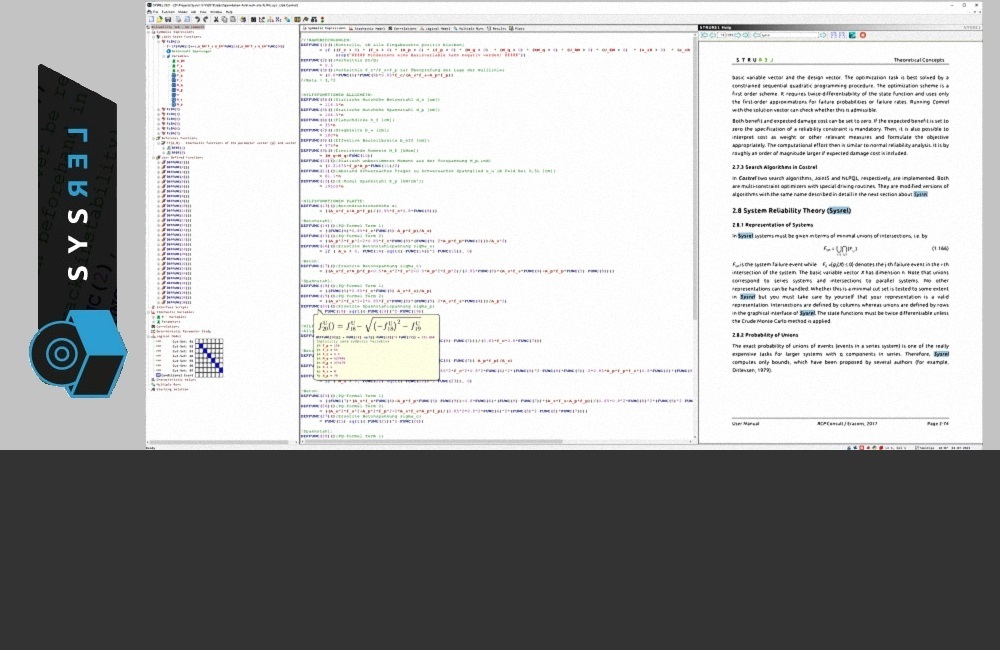
The additional package is SYSREL for system reliability analysis.
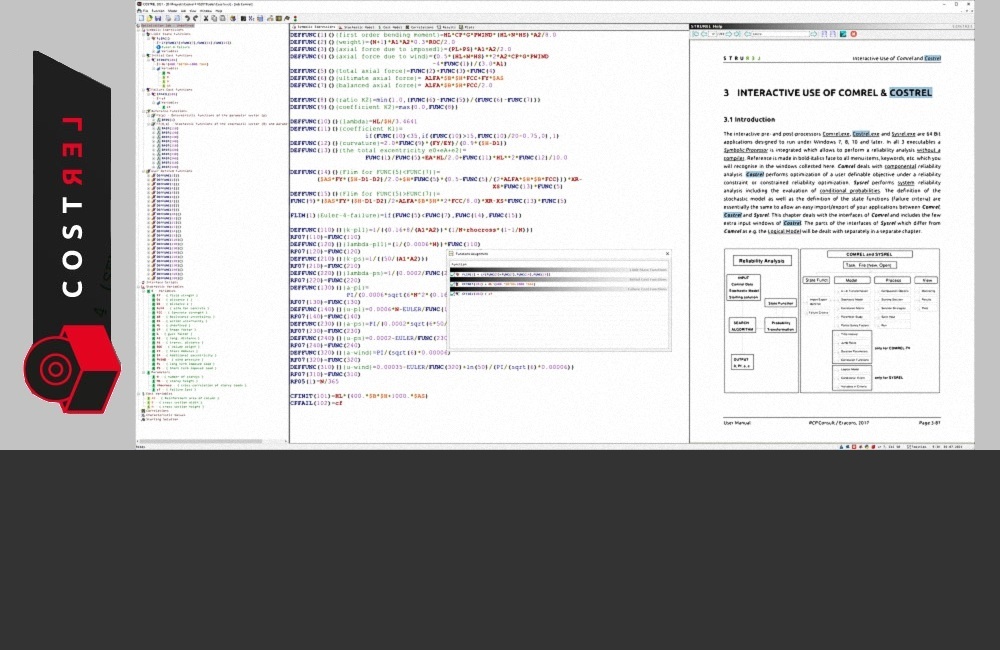
The next additional package is COSTREL for reliability based optimization.
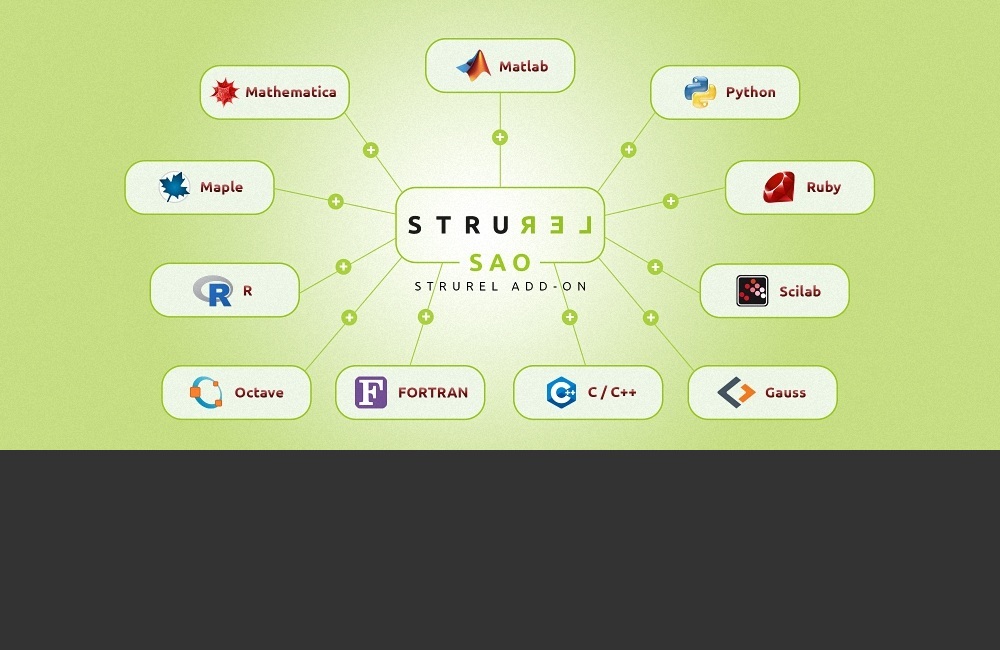
In reliability analysis, the goal is to assess the performance of models of varying complexity. Additionally to internal Symbolic language, STRUREL allows you to use limit-state functions coded in Maple, Mathematica, Matlab, Python, Ruby, Octave, R, Scilab, Gauss, FORTRAN and C/C++.
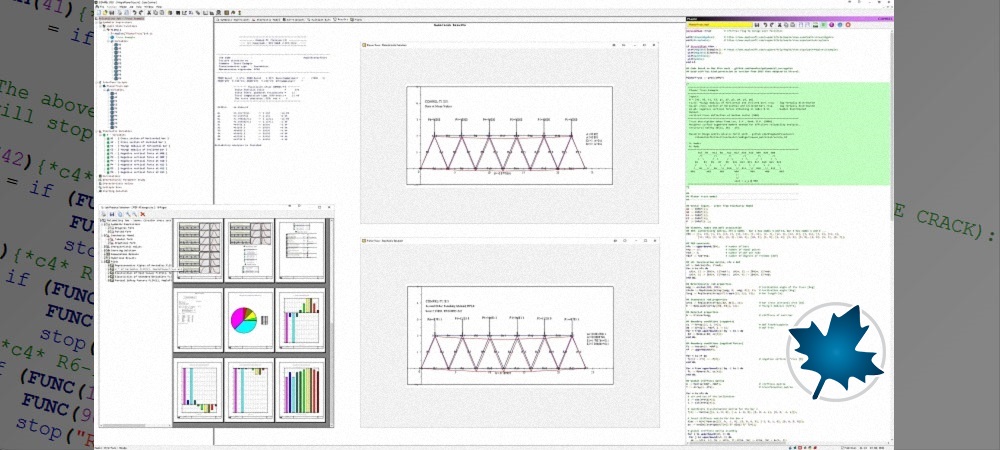
As a demonstration of the new capabilities we have taken from literature a well known example-structure: a plane truss with 23 bars and vertical loading. The failure criterion was deformation greater 11 cm in the middle of the lower girder. This example was analysed by all 11 engines with identical results in terms of probaility of failure. Additionally, for extended visualisation, deformations, member normal forces and von Mises stress plots were realised using graphical facilities of the corresponding engine. Click on picture above to get a full description.
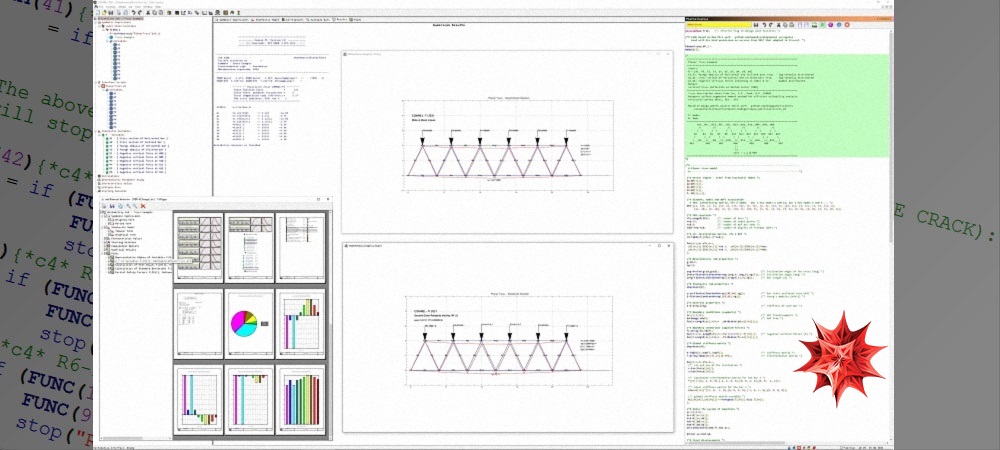
... the same example using Mathematica ... Click on picture above to get a full description.
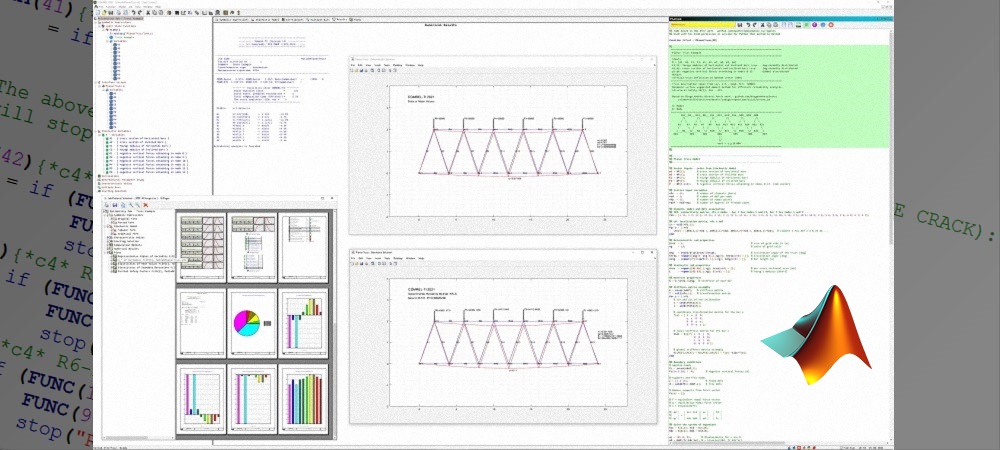
... the same example using Matlab ... Click on picture above to get a full description.
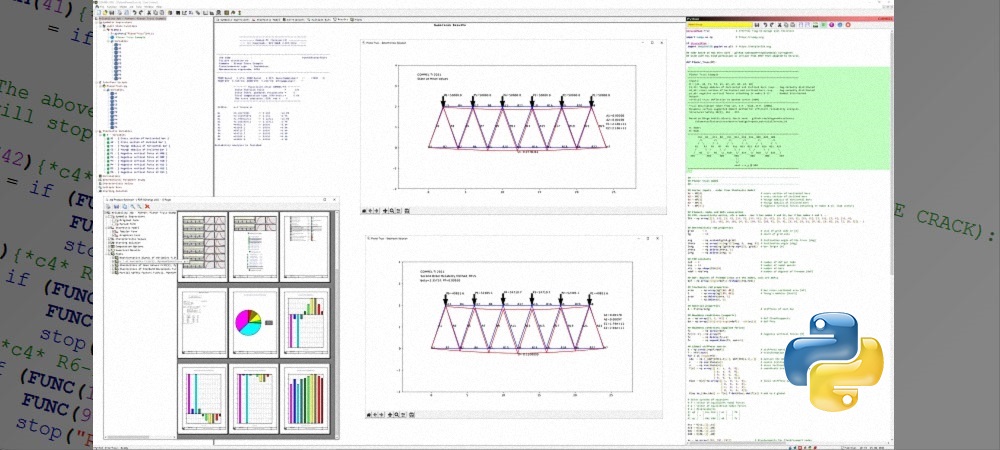
... the same example using Python and Matplotlib for visualization purposes ... Click on picture above to get a full description.
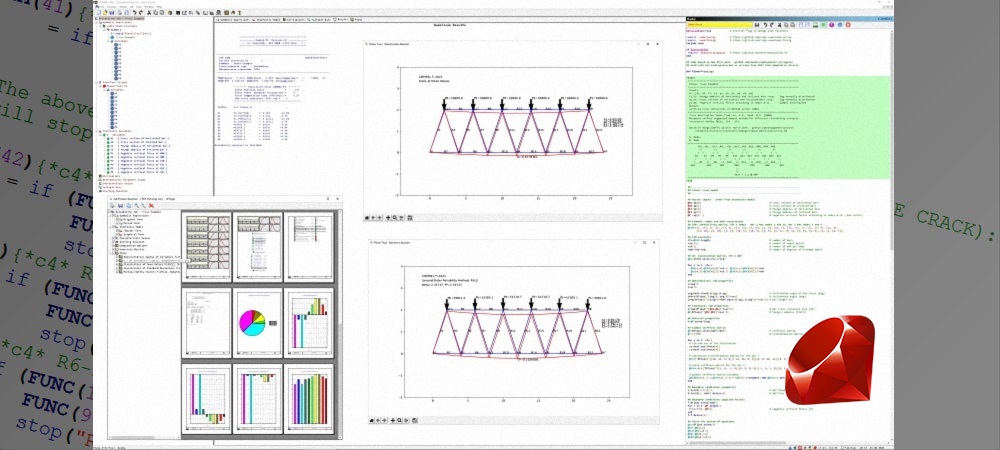
... the same example using Ruby and Matplotlib over PyPlot for visualization purposes ... Click on picture above to get a full description.
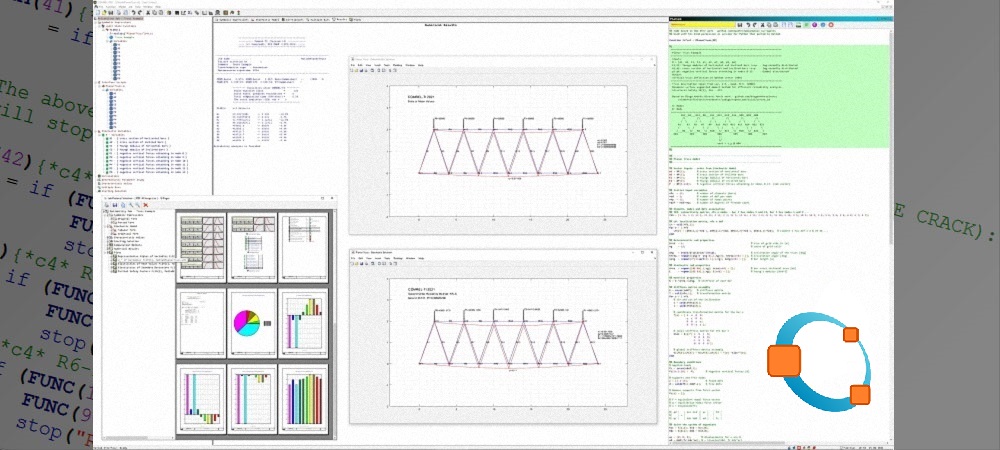
... the same example using Octave ... Click on picture above to get a full description.
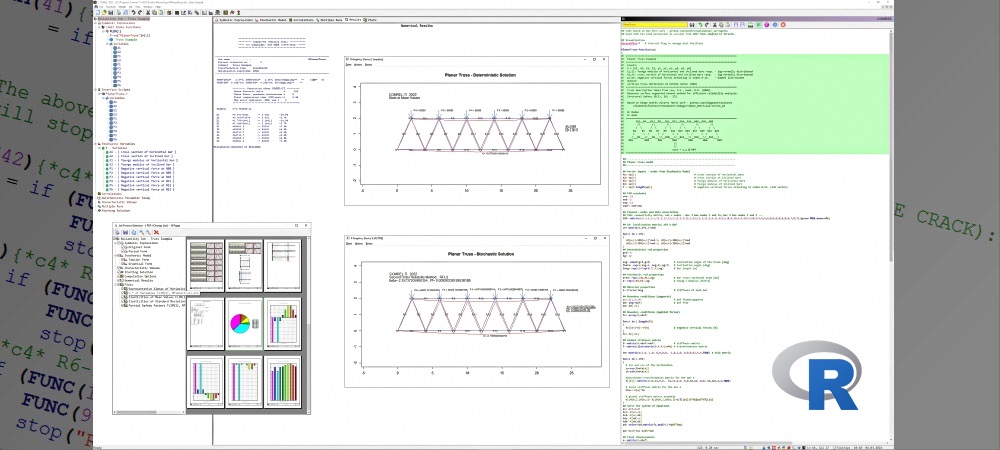
... the same example using R and ggplot2 with colormap for visualization purposes ... Click on picture above to get a full description.
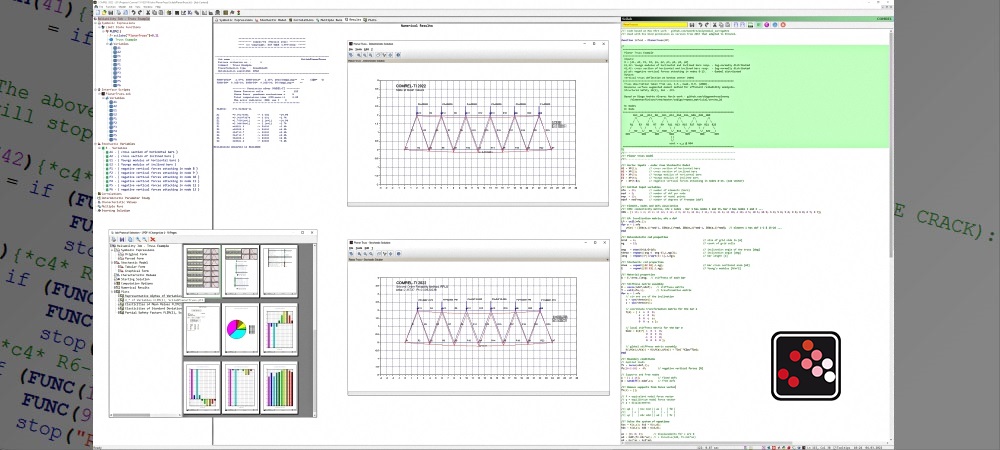
... the same example using Scilab ... Click on picture above to get a full description.
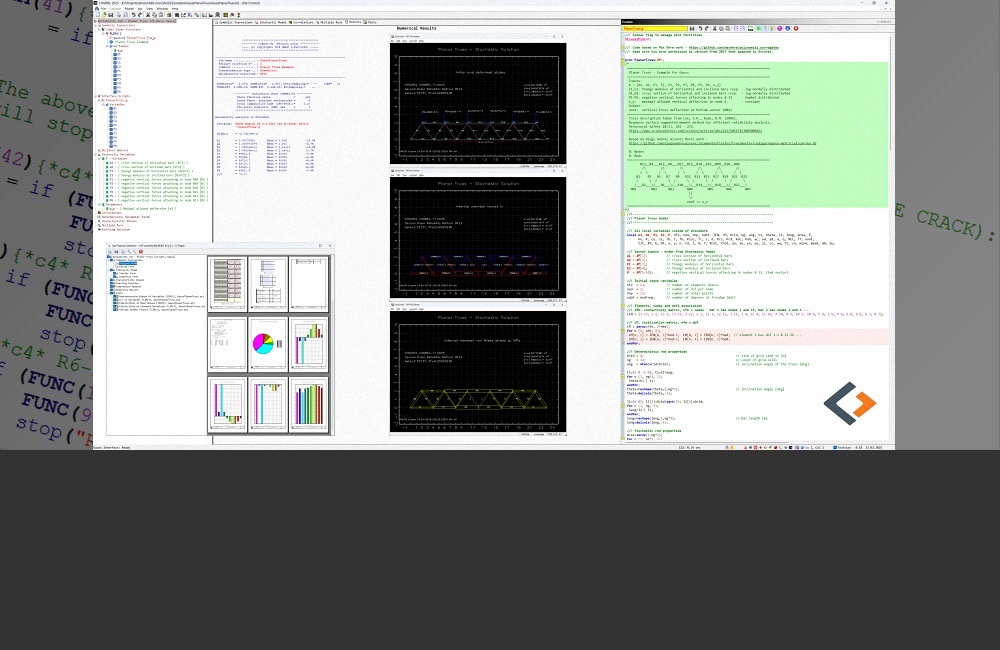
... the same example using Gauss ... Click on picture above to get a full description.
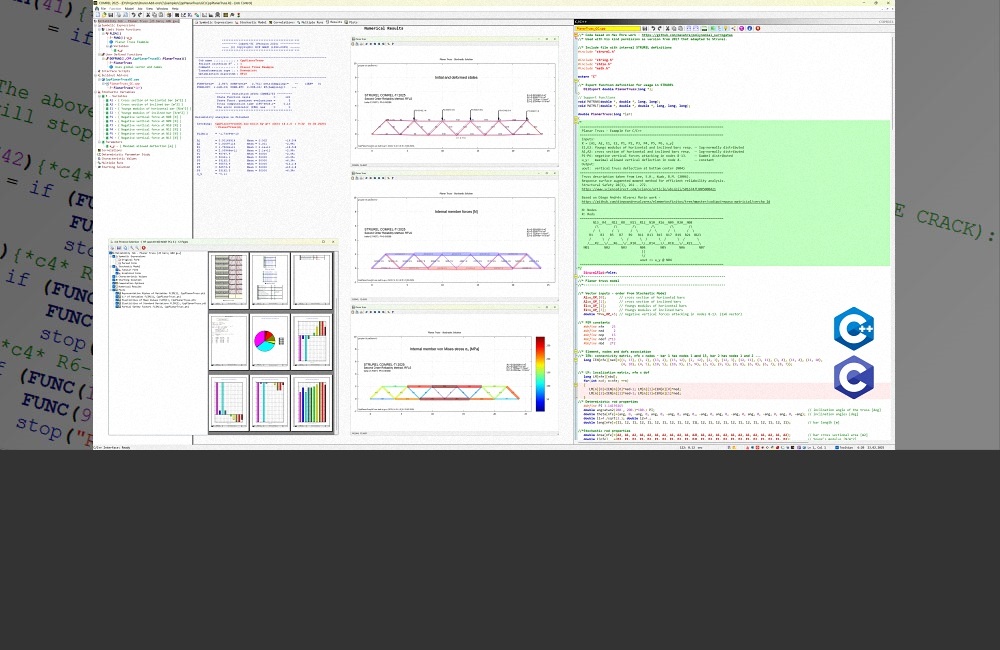
... the same example using C/C++ and built-in connectivity to Gnuplot for visualization purposes ... Click on picture above to get a full description.
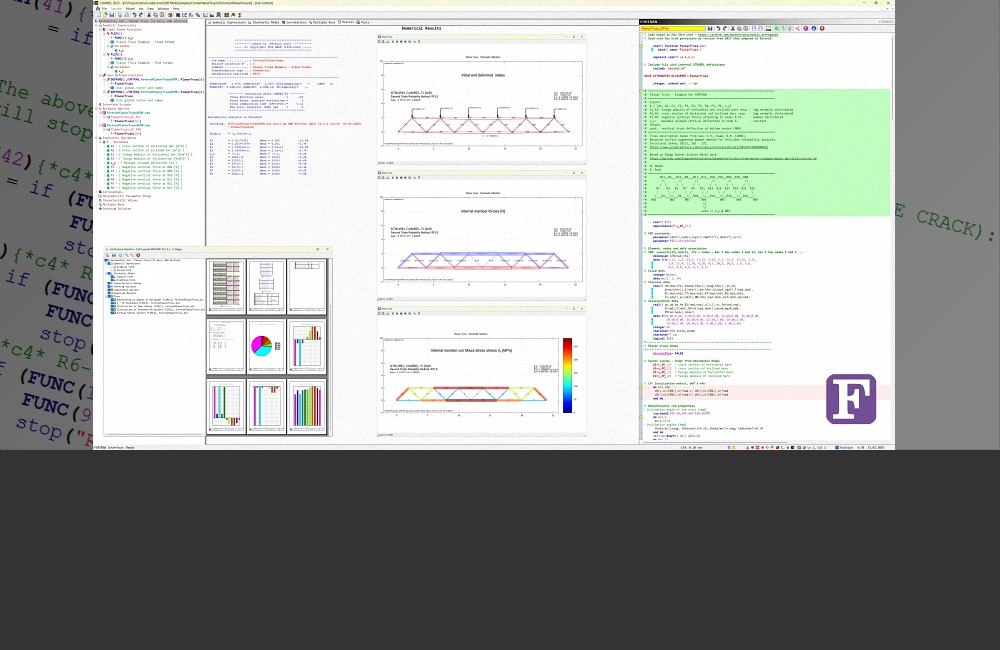
... the same example using FORTRAN and built-in connectivity to Gnuplot for visualization purposes ... Click on picture above to get a full description.
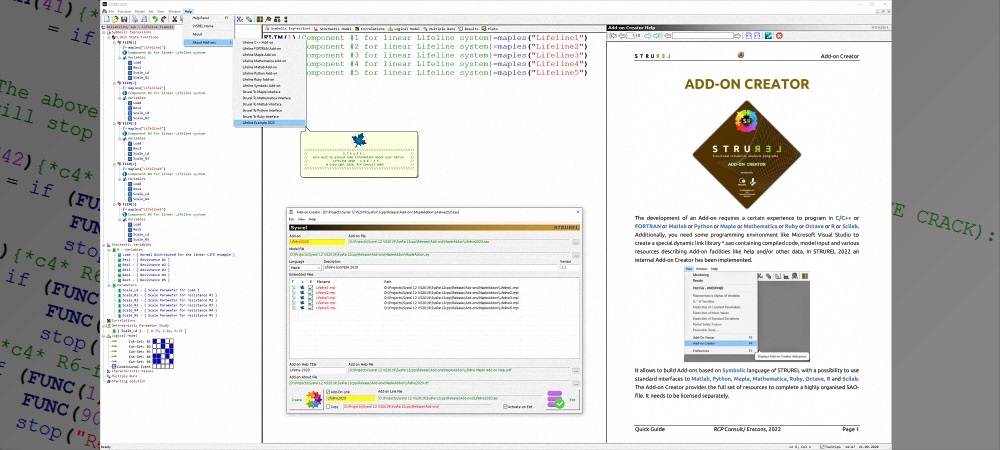
You can develop your own STRUREL Add-Ons using SAO SDK or the integrated Add-on Creator 2 to achieve external environments by interfaces implemented in STRUREL. State-of-the-art reliability methods of STRUREL are used in module RELY of SOFiSTIK also. More details can be found here. Click on picture above to get a full description.
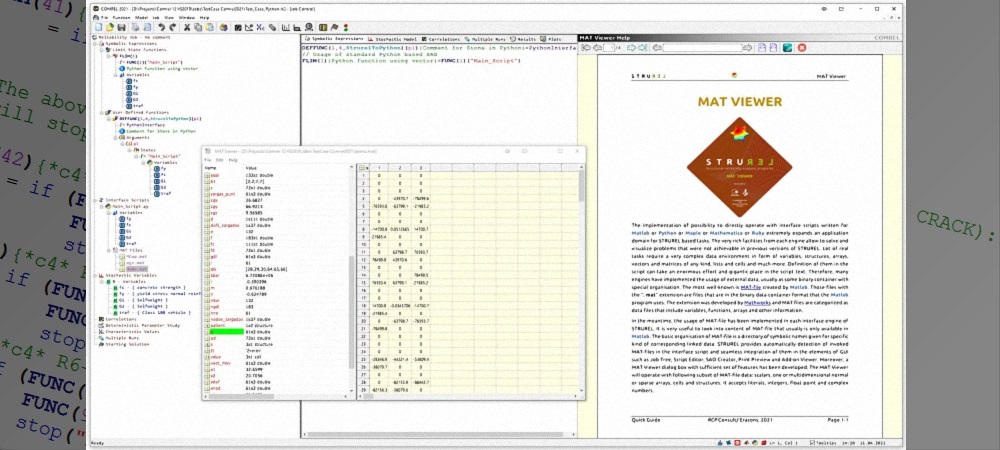
MAT and HDF5 files can be used to store or load scalars, vectors or matrices within the external scripts linked to STRUREL. These files are primarily used in the context of Matlab, but can also be accessed from Python, Maple, Mathematica, Ruby, Octave, R, Scilab, Gauss, FORTRAN or C/C++. Click on picture above to get a full description.
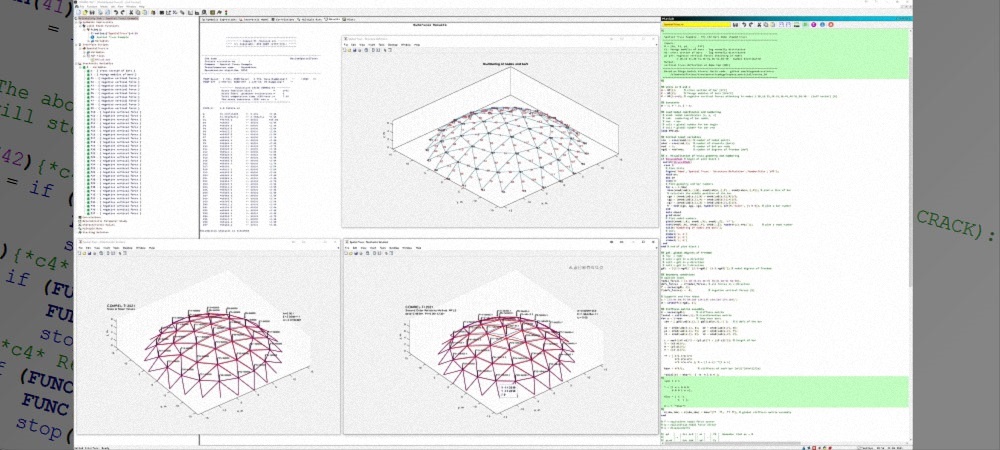
We analysed a complex spatial globe structure under different wind loads.
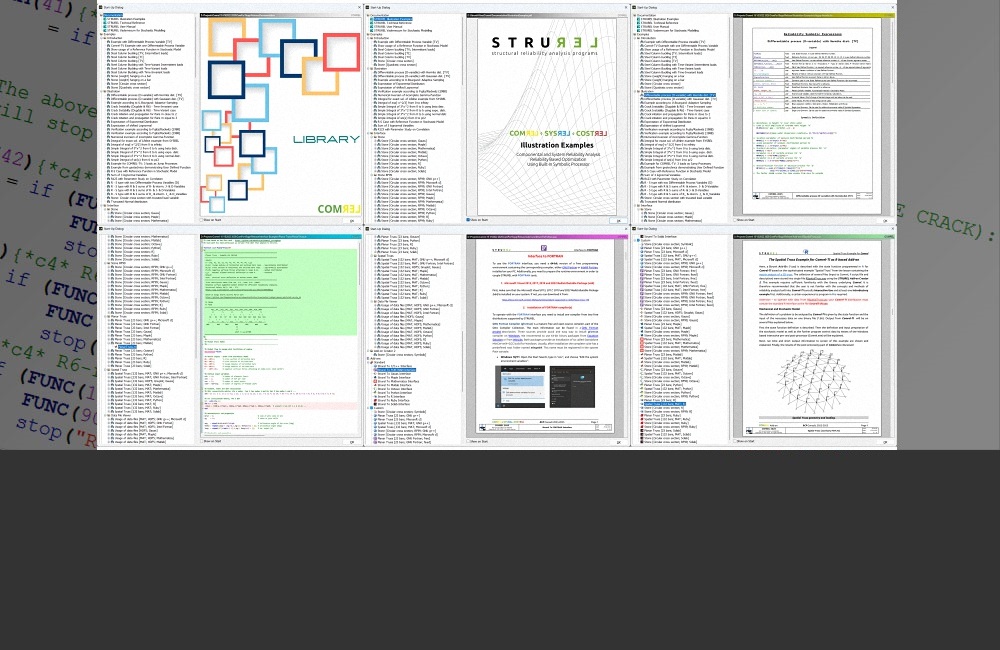
In the last 10 years STRUREL was widely extended and lot of additional examples were created to demonstrate new features and interfaces. To provide a quick overview of the examples and to get a feeling of the GUI features a very powerful Start-Up Dialog was implemented. It provides an accelerated facility for self educational handling of all model files and all interface scripts or source files used.
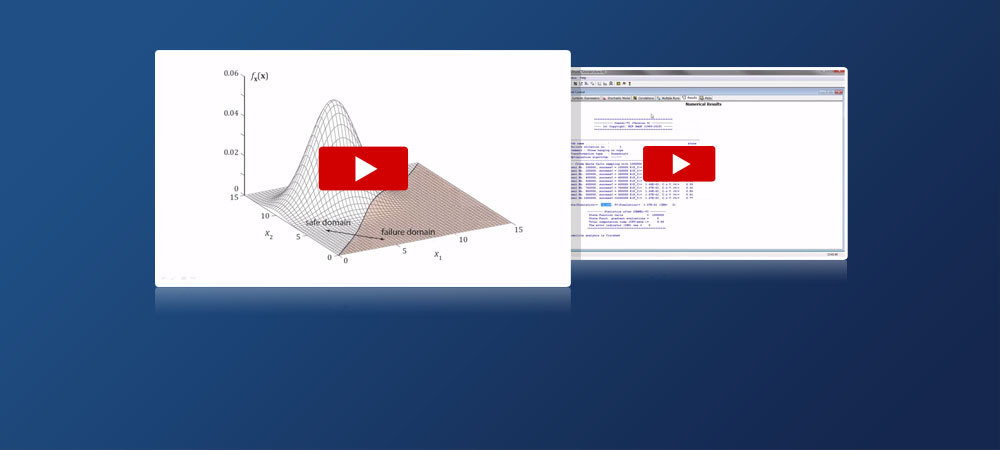
On the education page, you will find a series of video tutorials that demonstrate the use of the STRUREL programs.

Due to material deficiencies and changes in safety requirements, existing overhead transmission towers must undergo a verification of their reliability. STRUREL powers the software P242 for FE based reliability analysis of these towers, which was developed in collaboration with major German electrical infrastructure companies. Due to its user-friendly and effective design, the software is used efficiently to verify 1000s of transmission towers.
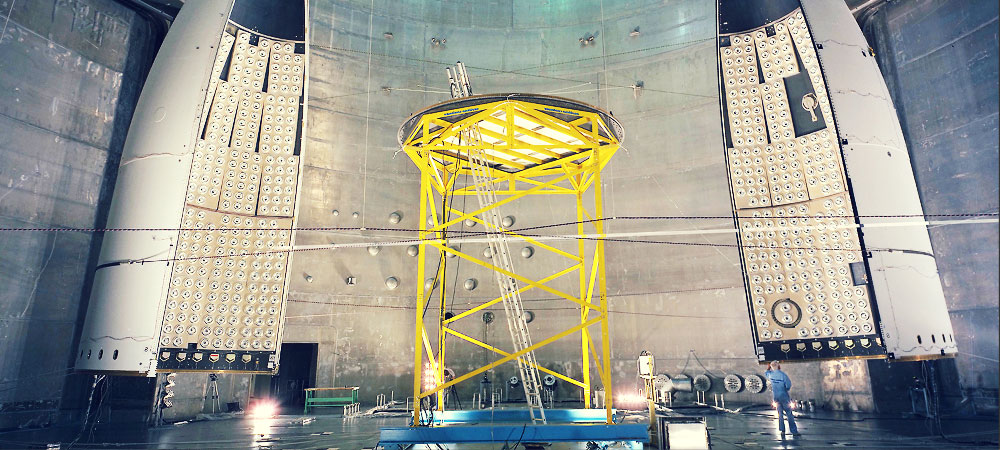
STRUREL supported the design and manufacturing of critical components of aerospace structures, including the high-strength steel booster case of Ariane 5 for which an exhaustive reliability assessment was performed. The reliability updating capabilities of STRUREL allowed optimizing the expensive proof-tests that are part of the manufacturing process.

STRUREL was central in verifying and demonstrating the reliability of the Storebæltsbroen cable bridge. The effect of cable failures on the reliability of the bridge was investigated with the unique system reliability tools incorporated in STRUREL. These allow to efficiently assess systems with large numbers of failure modes.

The 2025 release of STRUREL including Comrel, Sysrel and Costrel provides considerably improved handling of interfaces to Maplesoft Maple, Wolfram Research Mathematica, MathWorks Matlab, Python, Ruby, GNU Octave, R, Scilab, Aptech GAUSS engines and newly developed seamless integration for FORTRAN and C/C++ languages. Sophisticated technology to create so called Buildout Add-ons on the fly using latest versions of well-known compilers, such as GNU Fortran/C++, INTEL oneAPI Fortran and Microsoft Visual C++ was implemented. Editing source code is almost identical as for scripts of interpreting engines. A built-in Script Editor provides a syntax coloring, folding support with hot areas for collapsible nodes, automatic detection of URL as a clickable link, braces highlighting, extended RTF export, deep error tracing and numerical evaluation on the fly. STRUREL can now handle MAT and HDF5 files in each interface. Before execution of a changed script the engine will be automatically restarted. In the case of altered source file, a new state of Buildout Add-on will be manufactured and used on the fly. The implementation of special prologue/epilogue function RF99 optimizes visualization of results. Additionally, FORTRAN and C/C++ interfaces contain a simplified built-in connection to Gnuplot that allows produce a wide range of plots too. To provide a quick overview of the examples and to get a feeling of the GUI facilities a very powerful Start-Up Dialog was implemented. Now it is also possible to operate just the numerical core of each module for automation purposes. For example, some external application may call the STRUREL program in an iterative loop for predefined input model and update parameters of interest until some aim is reached. We proudly announce the first successful automation of commercial FEM Suites - FEMAP/NASTRAN and PLAXIS from STRUREL via its Python interface. Furthermore, there are: Retranslator Mathematical Formulas (RMF) that converts text formulae back into mathematical notation, a Help system based on PDF standard, context sensitive help for the Symbolic Expressions Editor, simplified interface functions to all script-based engines, comfortable Run control. The new version of Add-on Creator 2 allows to easily build STRUREL custom Add-Ons. Each standard interface now can generate a Run Script file that encloses all steps of a reliability analysis using the language of the corresponding engine. Therefore, it is possible to execute a bundle of a Run Script together with the corresponding script of the state function on Windows, Linux and macOS without invoking STRUREL software.

STRUREL is a collection of programs for stuructural reliability analysis. More details can be found here.

The core package is COMREL for component reliability analysis.

The additional package is SYSREL for system reliability analysis.

The next additional package is COSTREL for reliability based optimization.

In reliability analysis, the goal is to assess the performance of models of varying complexity. Additionally to internal Symbolic language, STRUREL allows you to use limit-state functions coded in Maple, Mathematica, Matlab, Python, Ruby, Octave, R, Scilab, Gauss, FORTRAN and C/C++.

As a demonstration of the new capabilities we have taken from literature a well known example-structure: a plane truss with 23 bars and vertical loading. The failure criterion was deformation greater 11 cm in the middle of the lower girder. This example was analysed by all 11 engines with identical results in terms of probaility of failure. Additionally, for extended visualisation, deformations, member normal forces and von Mises stress plots were realised using graphical facilities of the corresponding engine. Click on picture above to get a full description.

... the same example using Mathematica ... Click on picture above to get a full description.

... the same example using Matlab ... Click on picture above to get a full description.

... the same example using Python and Matplotlib for visualization purposes ... Click on picture above to get a full description.

... the same example using Ruby and Matplotlib over PyPlot for visualization purposes ... Click on picture above to get a full description.

... the same example using Octave ... Click on picture above to get a full description.

... the same example using R and ggplot2 with colormap for visualization purposes ... Click on picture above to get a full description.

... the same example using Scilab ... Click on picture above to get a full description.

... the same example using Gauss ... Click on picture above to get a full description.

... the same example using C/C++ and built-in connectivity to Gnuplot for visualization purposes ... Click on picture above to get a full description.

... the same example using FORTRAN and built-in connectivity to Gnuplot for visualization purposes ... Click on picture above to get a full description.

You can develop your own STRUREL Add-Ons using SAO SDK or the integrated Add-on Creator 2 to achieve external environments by interfaces implemented in STRUREL. State-of-the-art reliability methods of STRUREL are used in module RELY of SOFiSTIK also. More details can be found here. Click on picture above to get a full description.

MAT and HDF5 files can be used to store or load scalars, vectors or matrices within the external scripts linked to STRUREL. These files are primarily used in the context of Matlab, but can also be accessed from Python, Maple, Mathematica, Ruby, Octave, R, Scilab, Gauss, FORTRAN or C/C++. Click on picture above to get a full description.

We analysed a complex spatial globe structure under different wind loads.

In the last 10 years STRUREL was widely extended and lot of additional examples were created to demonstrate new features and interfaces. To provide a quick overview of the examples and to get a feeling of the GUI features a very powerful Start-Up Dialog was implemented. It provides an accelerated facility for self educational handling of all model files and all interface scripts or source files used.

On the education page, you will find a series of video tutorials that demonstrate the use of the STRUREL programs.

Due to material deficiencies and changes in safety requirements, existing overhead transmission towers must undergo a verification of their reliability. STRUREL powers the software P242 for FE based reliability analysis of these towers, which was developed in collaboration with major German electrical infrastructure companies. Due to its user-friendly and effective design, the software is used efficiently to verify 1000s of transmission towers.

STRUREL supported the design and manufacturing of critical components of aerospace structures, including the high-strength steel booster case of Ariane 5 for which an exhaustive reliability assessment was performed. The reliability updating capabilities of STRUREL allowed optimizing the expensive proof-tests that are part of the manufacturing process.

STRUREL was central in verifying and demonstrating the reliability of the Storebæltsbroen cable bridge. The effect of cable failures on the reliability of the bridge was investigated with the unique system reliability tools incorporated in STRUREL. These allow to efficiently assess systems with large numbers of failure modes.

The 2025 release of STRUREL including Comrel, Sysrel and Costrel provides considerably improved handling of interfaces to Maplesoft Maple, Wolfram Research Mathematica, MathWorks Matlab, Python, Ruby, GNU Octave, R, Scilab, Aptech GAUSS engines and newly developed seamless integration for FORTRAN and C/C++ languages. Sophisticated technology to create so called Buildout Add-ons on the fly using latest versions of well-known compilers, such as GNU Fortran/C++, INTEL oneAPI Fortran and Microsoft Visual C++ was implemented. Editing source code is almost identical as for scripts of interpreting engines. A built-in Script Editor provides a syntax coloring, folding support with hot areas for collapsible nodes, automatic detection of URL as a clickable link, braces highlighting, extended RTF export, deep error tracing and numerical evaluation on the fly. STRUREL can now handle MAT and HDF5 files in each interface. Before execution of a changed script the engine will be automatically restarted. In the case of altered source file, a new state of Buildout Add-on will be manufactured and used on the fly. The implementation of special prologue/epilogue function RF99 optimizes visualization of results. Additionally, FORTRAN and C/C++ interfaces contain a simplified built-in connection to Gnuplot that allows produce a wide range of plots too. To provide a quick overview of the examples and to get a feeling of the GUI facilities a very powerful Start-Up Dialog was implemented. Now it is also possible to operate just the numerical core of each module for automation purposes. For example, some external application may call the STRUREL program in an iterative loop for predefined input model and update parameters of interest until some aim is reached. We proudly announce the first successful automation of commercial FEM Suites - FEMAP/NASTRAN and PLAXIS from STRUREL via its Python interface. Furthermore, there are: Retranslator Mathematical Formulas (RMF) that converts text formulae back into mathematical notation, a Help system based on PDF standard, context sensitive help for the Symbolic Expressions Editor, simplified interface functions to all script-based engines, comfortable Run control. The new version of Add-on Creator 2 allows to easily build STRUREL custom Add-Ons. Each standard interface now can generate a Run Script file that encloses all steps of a reliability analysis using the language of the corresponding engine. Therefore, it is possible to execute a bundle of a Run Script together with the corresponding script of the state function on Windows, Linux and macOS without invoking STRUREL software.

STRUREL is a collection of programs for stuructural reliability analysis. More details can be found here.

The core package is COMREL for component reliability analysis.

The additional package is SYSREL for system reliability analysis.

The next additional package is COSTREL for reliability based optimization.

In reliability analysis, the goal is to assess the performance of models of varying complexity. Additionally to internal Symbolic language, STRUREL allows you to use limit-state functions coded in Maple, Mathematica, Matlab, Python, Ruby, Octave, R, Scilab, Gauss, FORTRAN and C/C++.

As a demonstration of the new capabilities we have taken from literature a well known example-structure: a plane truss with 23 bars and vertical loading. The failure criterion was deformation greater 11 cm in the middle of the lower girder. This example was analysed by all 11 engines with identical results in terms of probaility of failure. Additionally, for extended visualisation, deformations, member normal forces and von Mises stress plots were realised using graphical facilities of the corresponding engine. Click on picture above to get a full description.

... the same example using Mathematica ... Click on picture above to get a full description.

... the same example using Matlab ... Click on picture above to get a full description.

... the same example using Python and Matplotlib for visualization purposes ... Click on picture above to get a full description.

... the same example using Ruby and Matplotlib over PyPlot for visualization purposes ... Click on picture above to get a full description.

... the same example using Octave ... Click on picture above to get a full description.

... the same example using R and ggplot2 with colormap for visualization purposes ... Click on picture above to get a full description.

... the same example using Scilab ... Click on picture above to get a full description.

... the same example using Gauss ... Click on picture above to get a full description.

... the same example using C/C++ and built-in connectivity to Gnuplot for visualization purposes ... Click on picture above to get a full description.

... the same example using FORTRAN and built-in connectivity to Gnuplot for visualization purposes ... Click on picture above to get a full description.

You can develop your own STRUREL Add-Ons using SAO SDK or the integrated Add-on Creator 2 to achieve external environments by interfaces implemented in STRUREL. State-of-the-art reliability methods of STRUREL are used in module RELY of SOFiSTIK also. More details can be found here. Click on picture above to get a full description.

MAT and HDF5 files can be used to store or load scalars, vectors or matrices within the external scripts linked to STRUREL. These files are primarily used in the context of Matlab, but can also be accessed from Python, Maple, Mathematica, Ruby, Octave, R, Scilab, Gauss, FORTRAN or C/C++. Click on picture above to get a full description.

We analysed a complex spatial globe structure under different wind loads.

In the last 10 years STRUREL was widely extended and lot of additional examples were created to demonstrate new features and interfaces. To provide a quick overview of the examples and to get a feeling of the GUI features a very powerful Start-Up Dialog was implemented. It provides an accelerated facility for self educational handling of all model files and all interface scripts or source files used.

On the education page, you will find a series of video tutorials that demonstrate the use of the STRUREL programs.

Due to material deficiencies and changes in safety requirements, existing overhead transmission towers must undergo a verification of their reliability. STRUREL powers the software P242 for FE based reliability analysis of these towers, which was developed in collaboration with major German electrical infrastructure companies. Due to its user-friendly and effective design, the software is used efficiently to verify 1000s of transmission towers.

STRUREL supported the design and manufacturing of critical components of aerospace structures, including the high-strength steel booster case of Ariane 5 for which an exhaustive reliability assessment was performed. The reliability updating capabilities of STRUREL allowed optimizing the expensive proof-tests that are part of the manufacturing process.

STRUREL was central in verifying and demonstrating the reliability of the Storebæltsbroen cable bridge. The effect of cable failures on the reliability of the bridge was investigated with the unique system reliability tools incorporated in STRUREL. These allow to efficiently assess systems with large numbers of failure modes.
Actions on structures such as wind, earthquake and machinery vibrations, as well as the capacity of structural elements, the material properties, and the geometry of a structure are typically not known with certainty. STRUREL can account for all types of uncertainties and offers a powerful tool set for setting up probabilistic models of engineering structures/systems.

Download the largely extended demo version of STRUREL 2025 today! See how to visualize results using interface built-in plotting facilities or additional libraries such as Gnuplot, matplotlib, tkinter, ggplot2 and more. Test our efficient implementation of state-of-the-art methods for structural safety.
Our software product STRUREL is the indispensable tool for working with probabilistic models. STRUREL allows to efficiently assess the risk/reliability associated with engineering structures/systems - even if the underlying engineering model is computationally expensive to evaluate. STRUREL was founded at the Technische Universität München (TUM) and has been developed and tested for more than 30 years.

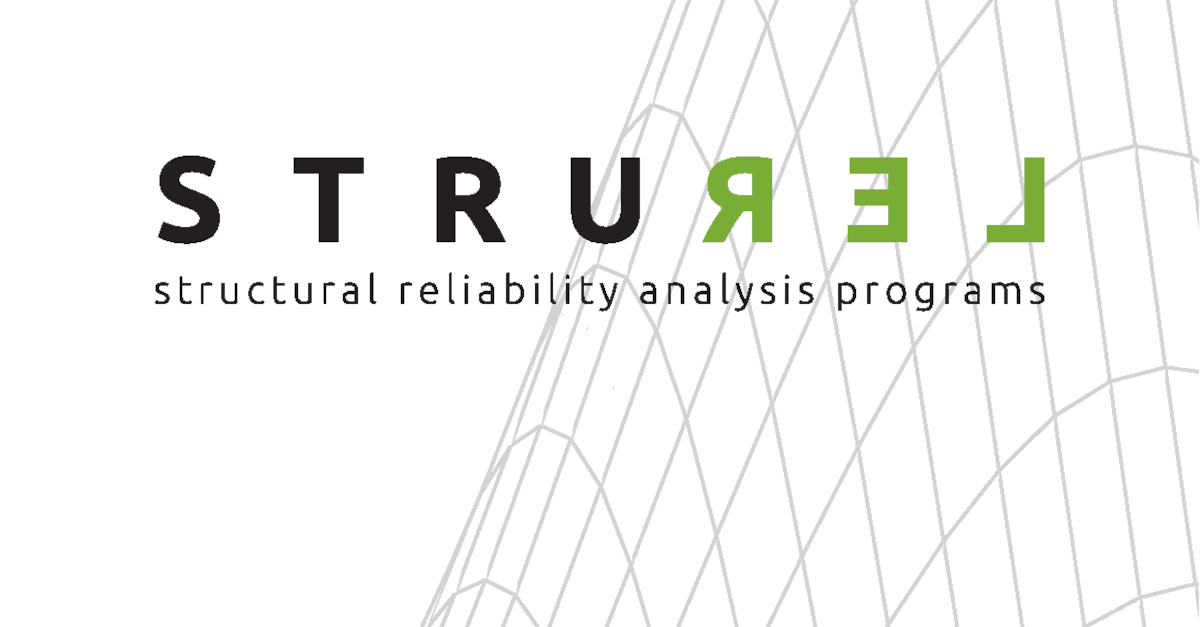
To stay up-to-date with the latest news and announcements regarding STRUREL, you can subscribe to the Strurel-News-Feed.


Imprint | 2025 RCP & ERACONS. All rights reserved.

